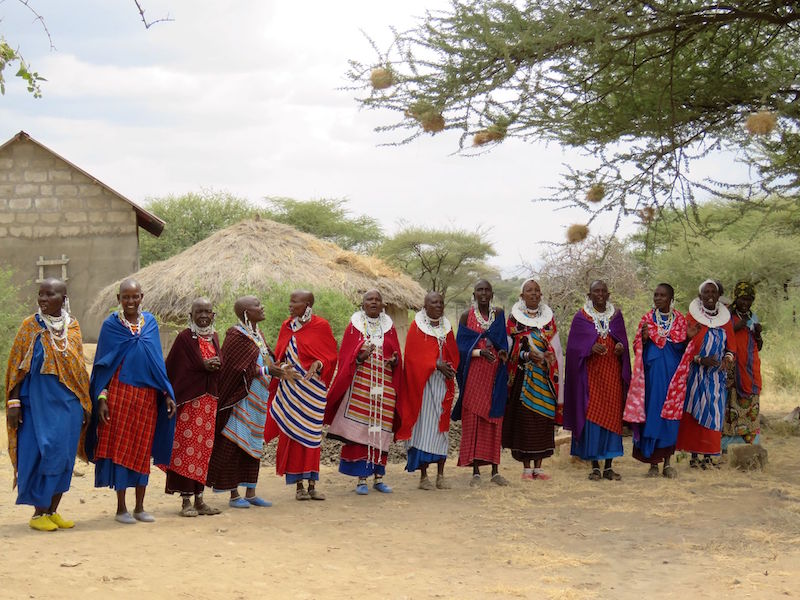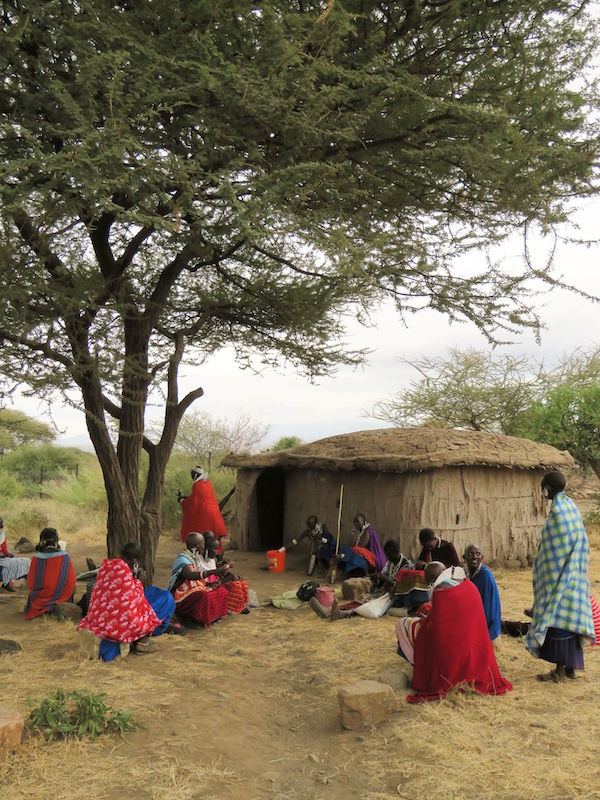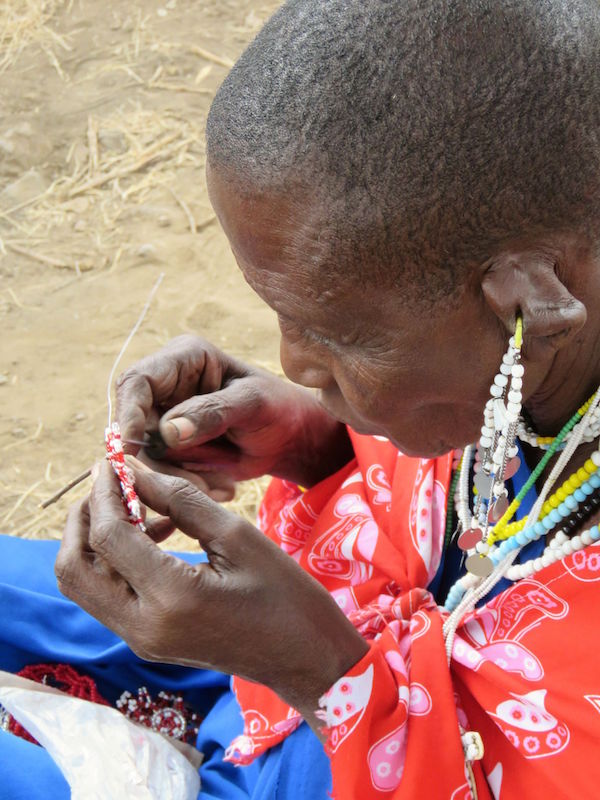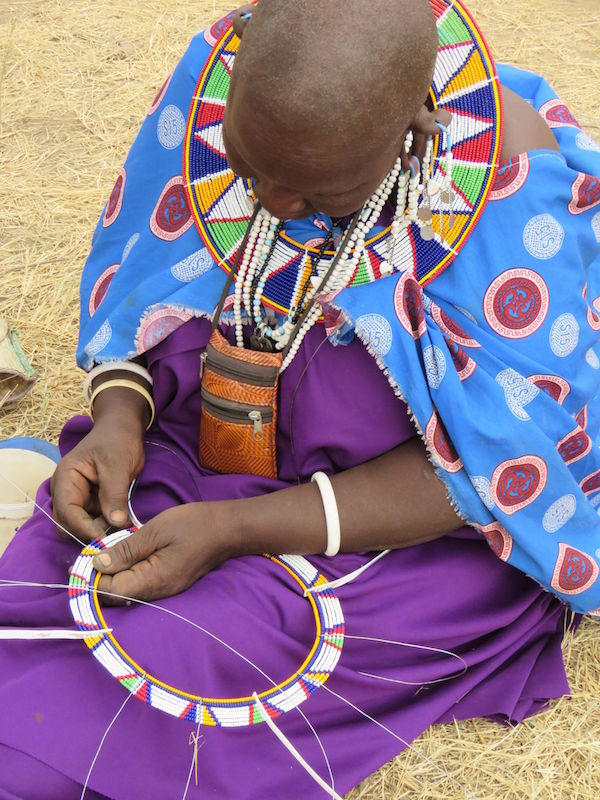Stories from Tanzania, Africa
By Kathleen Bozis |
|---|
The Curious Incident of the Elephants in the Nighttime
August 22, 2016
By Kathleen Bozis -
with photos available at Ryan Bozis Shutterfly Gallery until closing 03/27/2023.
We stayed one night at a tented lodge in the Tarangire National Park. We arrived to a gorgeous lodge with indoor dining, swimming pool and an expansive deck overlooking the wildlife park. Being our first lodging in a national park, we were very impressed. We were assigned our tents and a guide led us to it. We were firmly instructed that we were not to walk between the lodge and tent after dark - we were only to do so with one of the guides who had large flashlights. During the daytime, it was best to walk in groups of 2 or more. Our first clue that there is no fence between us and the wildlife.
The tent was what we came to know as a typical permanent safari tent. Large with a king size bed, running water/toilet/shower - every comfort we could possibly need. Drinking water provided. The guide got us a "monkey lock", which was a handmade wood block and wire contraption that apparently monkeys can't figure out (they are very handy with zippers). Our second indication that there is no fence . . .
We went to bed with all our tent sides unzipped so we could feel the night air, as it was perfect sleeping weather. About 1:30 in the morning, Ryan heard some "rustling" or "crunching" sounds and woke up. I heard him and asked what was up. He said "I hear something" and we began listening and watching. Before long, an elephant moseyed out from behind the tent next to us. It was a huge mama. Behind it were a medium size adolescent and a baby elephant. The mama was sniffing the ground with her trunk, stopped and "pawed" at the ground. We heard the sound of rushing water and Ryan laughed saying "I think she's peeing!" A moment later we saw her drinking and realized she had broken a water pipe and water was coming out of the ground like a geyser! She would put the end of her truck over the hole and just slurp it up, and sometimes lift her trunk and pour the water into her mouth. We were like, wow! This is awesome to see!
When she'd had her fill, she and her family walked behind our tent and we lost sight of them. Momentarily, we again heard rushing water, from the rear of the next tent over. Some other source of water had been found and they were all three drinking from that. At this point, we starting thinking "What do we do?" We know water is a precious commodity here and it's the dry season and there is water just shooting out of the ground with no end in sight. Our cell phones don't work to call the lodge and we are not going out of the tent, especially since there are multiple tonnages of elephant within eye sight. So, we shrugged, and thought, well, maybe they do this every night? All we can do is watch and enjoy!
Next the elephants disappeared behind the next tent and walked around to the front of ours. All three were standing directly in front of our door! We remained quiet and just watched. They wandered over to a tree within eye sight and started eating the leaves. Midnight buffet? After munching for a while, it seemed the mama realized the baby couldn't reach the leaves, so she placed her huge head against the tree and pushed, deftly knocking it over and pulling the tree of out the ground, roots and all. They all three began munching away.
A light went on in the tent next to us and we heard people speaking German. There was still water rushing behind their tent. Within a few moments all was quiet, and we watched until they moved on.
Never once did fear cross our minds. What an experience! At daylight a staff person came walking down toward out tent. Ryan called out "The elephants were here!" Repairs were still being made when we left.
Moral to the story? What an elephant wants, it will have.
|
|---|
 |
MaaSAE Girls Lutheran Secondary School
August 22, 2016
By Kathleen Bozis -
with photos available at Ryan Bozis Shutterfly Gallery until closing 03/27/2023.
One of the tribes that lives in northern Tanzania is the Maasai. During our trip, we were fortunate to visit many Lutheran Church of Tanzania ministries, most notably a Lutheran Hospital in Arusha, a Maasai boma where we met the "bead ladies" and the Maasae Girls Lutheran Secondary School, also sponsored by the church. This story is about the girl's school.
Primary school (grades 1-6) is compulsory in Tanzania for both boys and girls. After that schooling depends on their economic circumstances and their propensity and interest in continuing their education. From what we could see of northern Tanzania, the secondary schools are boarding schools, as it is very rural and there are no "neighborhood schools". So sending a child to secondary school means paying fees and sending your children elsewhere to live. Many Maasai children return home to their boma after primary school to continue their life with their families as goat and cattle herders.
We rode buses from the city of Arusha to visit the Maasae Girls Secondary School. The principal/headmaster served us tea and explained why the church had started secondary schools for girls before our tour of the campus. The maasai culture is patrimonial and polygamous. Each male head of household typically marries 3-6 women and they all live together cooperatively in a "boma", which is a fenced in grouping of huts. Each woman and her children have their own hut, which is built by hand by the women. They are a pastoral people, so although they have a permanent home base, the boys are often out herding their goats, cows and sheep which is their main livelihood. The women of the family are expected to gather, purchase and prepare food and care for the children. The patriarch oversees all of this and our impression was that he doesn't do much of anything. When one of our party asked if spouse abuse was common, the principal hesitated and gave a wry smile. "It is usual", he said - it is part of the culture.
Female circumcision has been outlawed by the Tanzanian government, so people don't talk about it, but it still goes on. The principal guessed that 50% of girls still undergo this. However, the missionary we met with the next day guessed that within 10 years it will no longer exist, as women are beginning to speak up for their daughters.However, and here I quote, "it is not the more brutal form practiced in the northeast of Africa".
When girls are still in primary school, the staff of the secondary school approach them about continuing their education. The choice for the girls, who are 12-13 years old when they complete primary school, is to go home to their families and be given in marriage or to continue their schooling. The majority of families have no money to pay for continuing schooling for any of their children, least of all the girls. The principal said 98% of the girls WANT to continue their schooling because they are aware of what the alternative is. The girls that agree to continue their schooling take their final exams, and the secondary school staff is literally waiting outside the school to whisk them off to the secondary school. If they are not there to meet them, the families will come collect them, take them home and marry them off. As extra incentive for families with very few resources, their daughters bring a dowry, which means that it is financially advantageous to marry their daughters as soon as they can. So the girls arrive at the maasae school with only the clothes on their back and a willingness to forsake family for their future. This happens in August.
The secondary school term does not start until January, so the girls move into the dorms to adjust to life in the school. They must be provided clothing, food, bedding, school supplies and everything needed to sustain themselves. During our visit, which was during the school break, the girls who didn't go home were out washing their laundry by hand and laying it out in the sun to dry. (memories of Guatemala with all the bushes covered with their beautiful woven cloth!) When school starts in January, it is a difficult transition from primary school, as they immediately start instruction in English, instead of Kiswahili. The principal said with a wry grin, there is also some "kiswinglish" used in the transition. The cost for school for a girl for one year is $1,000.00.
At secondary school, the girls can do four years of school, or 4 + 2 more, which readies them for college entrance. Almost all of them continue on to college, but if they don't, the school commits to support the girl until she is financially self-supporting - as the principal said "until they are safe". To our American, privileged ears this all sounds like nonsense, unloving, maybe even brutal. But seeing where they live and what little they have, I'm certain the families feel they have no choice. It's literally about survival.
A few days ago, Ryan and I were honored to make the donation to sponsor one girl for six years of school. We looked at the price - $6,000 - and thought, for us that's a lot of money, but will it make a significant difference inour lives? For a young maasai girl, it is literally life changing. Hopefully that girl's future children, both boys and girls, will have a different future, supported by their parents. At some point, we will get the name of a girl we are sponsoring. We hear we will be able to communicate with her by email. We will expect nothing of her but to try. And honestly, we dream of going back to Tanzania to see her graduate in 6 or 7 years and celebrate her future!
Also visit
http://www.bootstrapafrica.org/#!mglss/cllz
for more information.
|
|---|
 |
The Women Behind the Beadwork
August 22, 2016 -
with photos available at Ryan Bozis Shutterfly Gallery until closing 03/27/2023.
Asante Network is currently assisting women's groups in East Africa. The women who range in age from 20 - 60 are married and single mothers, widows, students, and grandmothers. These enterprising artisans all have similar goals. They want their children and grandchildren to have a better life. They know education for their children is the roadmap out of poverty and into a more prosperous future.
The women enjoy working together and this gathering time yields many benefits. The primary benefit is that meeting in unison provides a "social" outlet. Collectively they learn new skills, critique each other's work, solve common challenges, exchange ideas for new products and support the goals of the group.
In most cases, life is difficult. Their homes are small, usually two rooms and in some cases built by the women themselves. Around their houses may be small plots of land where they grow their own food. Some may own a goat, cow, pig, or a few chickens. Most have no running water or electricity. Water has to be carried from the communal well and gathering firewood for cooking is a daily chore. Children are trained early in life to help with these ongoing tasks. And yet, as difficult as circumstances are the women find much joy in life. They laugh often, sing joyfully and are willing to share what they have with others. Their reservoir of hope is inspirational.
By purchasing their artisan crafts, you are helping them earn money to feed, shelter, clothe, and educate the people for whom they are responsible, including many HIV/AIDS orphans. Asante (thank you in Swahili) for purchasing products that make a difference!
NAAPOK Maasai Women's Group, Tanzania
Ketumbeine, located in northeastern Tanzania, is home to this group of Maasai artisans. These talented, fiercely proud women are the crafters of beautiful bracelets, earrings, necklaces, napkin rings, Christmas ornaments, clergy stoles and Essos-beaded, collar necklaces. The art of beading is part of their heritage and culture. Their lifestyle, though no longer nomadic, still revolves around livestock. During the 5-month dry season when there is no grass, there is likewise no milk for the children and many simply stop growing until it rains. Sale of their crafts has become a critical lifeline for these women and their families.

Photos provided by
Ryan Bozis. |
 |

Click on photos
for larger versions. |
 |
 |
 |
|
|---|

© RYAN DON BOZIS. All rights reserved.
|